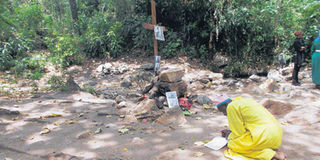In the midst of bubbling serenity

Legio Maria devotee praying at a shrine in Mberere.
What you need to know:
- Back on earth, we are wandering through a maze of narrow paths in the sugar cane fields in search of medicinal springs in Mberere.
- This is just one of the springs, she tells us and volunteers to show us around the grove where more springs pop up along the stream, which is akin to River Jordan for Legio Maria adherents.
At an elevation of 26,000 feet above-sea-level the half-hour flight from Nairobi to Kisumu offers an interesting eagle’s eye view of the land below.
Peak after peak is decked in farms, then suddenly a closed canopy forest appears — we are flying over the Aberdares.
The flight path changes and in no time we are over the sugar belt that stretches along Nandi Hills. Staring eye-level at Nandi Rock is awe-inspiring.
In my childhood, it was a rite of passage for children growing up in Kibos to conquer the hill where the gigantic rock sits supreme. In those days the hills were forested. Now bare rocks and farms clothe most of the chain of hills.
Back on earth, we are wandering through a maze of narrow paths in the sugar cane fields in search of medicinal springs in Mberere.
The touts accompanying us from the trading centre near the Songhor junction are quite sure the stream is somewhere around and sure enough we soon reach a grove of trees by a stream flowing past a gigantic sausage tree in fruit. A few feet from the crystal clear water, a man in a purple robe is deep in prayer at a shrine. This was truly unexpected.
The middle-aged man finishes his prayer and when he opens his eyes, we exchange greetings and engage in conversation. William Owino is from Oyugis, which is enroute to Homa Bay on Lake Victoria — almost 100 kilometres from here.
Owino is tall and lanky minus a whole row of lower teeth in his mouth – a result of a Luo cultural practice. He points to a corner by a tall tree where the springs bubble and flow through the grove and into the plantations.
“This is the shrine of the Legio Maria,” he says, pointing to the simple altar under the shade of a gigantic tree. Photocopied sepia pictures of the founder, Simeo Ondetto, and Mama Maria are stuck on the altar.
A woman in a long green tunic with a white scarf on her head appears from somewhere in the grove, and jumps over the stream to collect water from the spring in a calabash. Madine Rioha is from Isebania, a border town between Tanzania and Kenya. This is just one of the springs, she tells us and volunteers to show us around the grove where more springs pop up along the stream, which is akin to River Jordan for Legio Maria adherents.
Suddenly under the shaded canopy, there is a burst of colour breaking the monotony of green — a brilliant scarlet red underwing of a Ross’s turaco. “Ross’s turaco are usually found in quiet places,” says Mary Mbenge, Nature Kenya’s project officer based in Nandi. “It means that the worshippers don’t make a lot of noise.” The sacred site has no trash like plastic strewn around either.
Candles stand by the pictures of the founder, each little spring dedicated to a biblical figure. “People come here when they are sick or bewitched to be prayed for,” says the Kuria woman.
“There are different types of medicinal water in the groves for Mama Maria, Joseph, Michael the angel, Daniel, Abraham, and Catherine. We have a spring for Mama Maria because if we respect Jesus, the mother deserves more respect.” It is a nice quip for International Women’s Day.
The medicinal water is revered as Lazarus’s water. The followers believe it cures cancer and ulcers — Catherine’s spring cures stomach cramps while Abraham’s cures heart and lung ailments.
Madine offers some to us. It is carbonated. Our guide tells us she comes twice a year to pray and collect the healing water. She loves it here because she feels closer to God and even sleeps here in the night, hidden in the buttress roots of the fig tree. “In 1994, I was very sick and was prayed for by Legio Maria members.
I recovered and now I also have the power to pray for the sick and the jobless.”
A young man comes in quietly clothed in a bright yellow robe. He prays kneeling at the altar, then moves to the fork in a tree where he continues in silence, oblivious of us. Stepping out of the grove into bright sunlight, the nearest hill is another place of worship with caves to choose from, but in this heat I am in no mood to tackle it.




